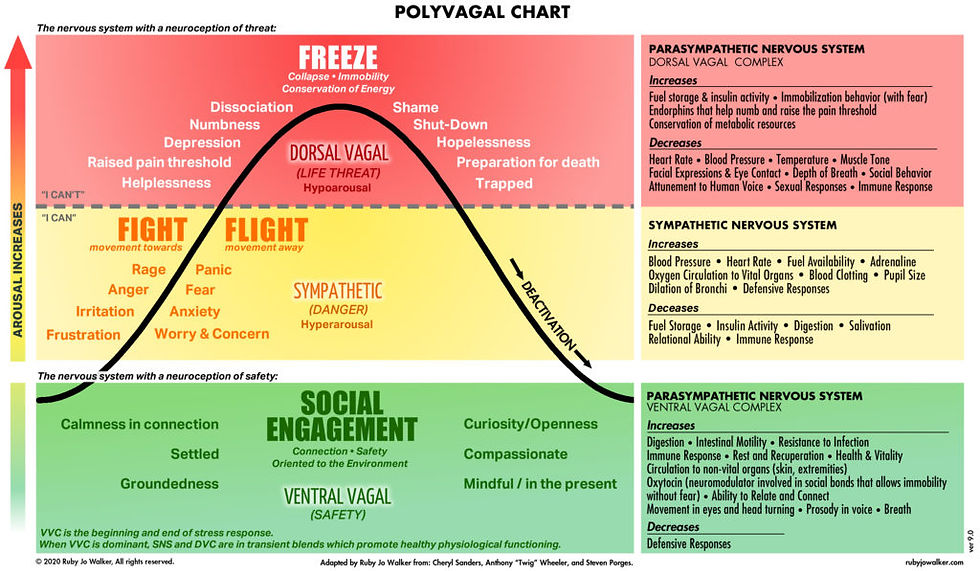Exploring Polyvagal Theory: The Body-Mind Connection
- Paige Danniella MJ

- Mar 9, 2023
- 3 min read
Have you ever felt stuck in a certain state that you just can't seem to break free from? Or maybe you've noticed that you tend to respond to certain situations in predictable ways? If so, you're not alone. Many of us find ourselves in a seemingly endless cycle of emotions and reactions that can be difficult to shift or change.
But what if I told you that there's a way to gain a deeper understanding of yourself and your patterns? Let's talk Polyvagal Theory.

Polyvagal Theory is a form of neuroscience that examines the connection between our nervous system and our emotions. It was developed by Dr Stephen Porges and introduced to me by my therapist. This theory is based on the idea that we can recognize and respond to our internal and external states in order to create positive changes in our lives.
In this blog post we will begin taking a look at how understanding this theory can help us unlock deeper understanding of ourselves and the patterns that may be influencing our automatic behaviours.
What is Polyvagal Theory?
Polyvagal Theory is a way of understanding how our autonomic nervous system works in relation to our psychological and emotional states. It is based on the premise that our autonomic nervous system is composed of three parts: the ventral vagal complex, the sympathetic nervous system, and the dorsal vagal complex. Each of these parts is responsible for different functions, and they all work together to maintain a sense of balance and wellbeing in our lives.
The ventral vagal complex is responsible for helping us to regulate our emotions, stay calm in stressful situations and build positive relationships with others. When we are operating out of this part of our system we feel grounded enough in our body and environment to be open to connection and compassion.
The sympathetic nervous system is responsible for the fight-or-flight response, which can be triggered in times of danger. Here we may feel anxiety, anger, worry or frustration.
Finally, the dorsal vagal complex is responsible for immobilizing us in certain situations, such as when we are feeling overwhelmed or threatened. When we are in these states we may feel numb, shutdown and unable to cope.
How Can Polyvagal Theory Help You?
By understanding the three components of the autonomic nervous system and how they work together, we can use Polyvagal Theory to recognize our own patterns and triggers. By recognizing our internal state at every opportunity, we can start to take steps to change our response to certain situations. For example, if we recognize that we tend to become overwhelmed in situations involving confrontation, we can start to take steps to develop strategies to cope with these situations.
Polyvagal Theory can also help us to become aware of how our emotions and reactions can be influenced by our environment. By understanding how our environment can impact our emotional state, we can make small changes in our environment to create a more positive atmosphere for ourselves. For example, if we recognize that we tend to become stressed in noisy environments, we can take steps to reduce the noise levels in our environment to create a more calming atmosphere.
If you're interested in using Polyvagal Theory as a way to gain a deeper understanding of yourself, the first step is to become familiar with the basics of the theory. You can do this by reading books or taking online courses on the subject or watching free YouTube or TikTok videos. It's also important to practice becoming mindful of your reactions and emotions in different situations. This will help you to recognize patterns and triggers in your life.
Once you have a better understanding of the theory and have begun to recognize these patterns in your life, you can start to experiment with different strategies for responding to these situations. So, if you recognize that you tend to become overwhelmed in situations involving confrontation, you can practice different strategies for staying calm and composed for when you do have those experiences.
Are you ready to start exploring Polyvagal Theory for yourself? Take the first step and start reading up on the basics or watch a few videos. Let me know what you think, email me at perceptionsbypaige@gmail.com












Comments